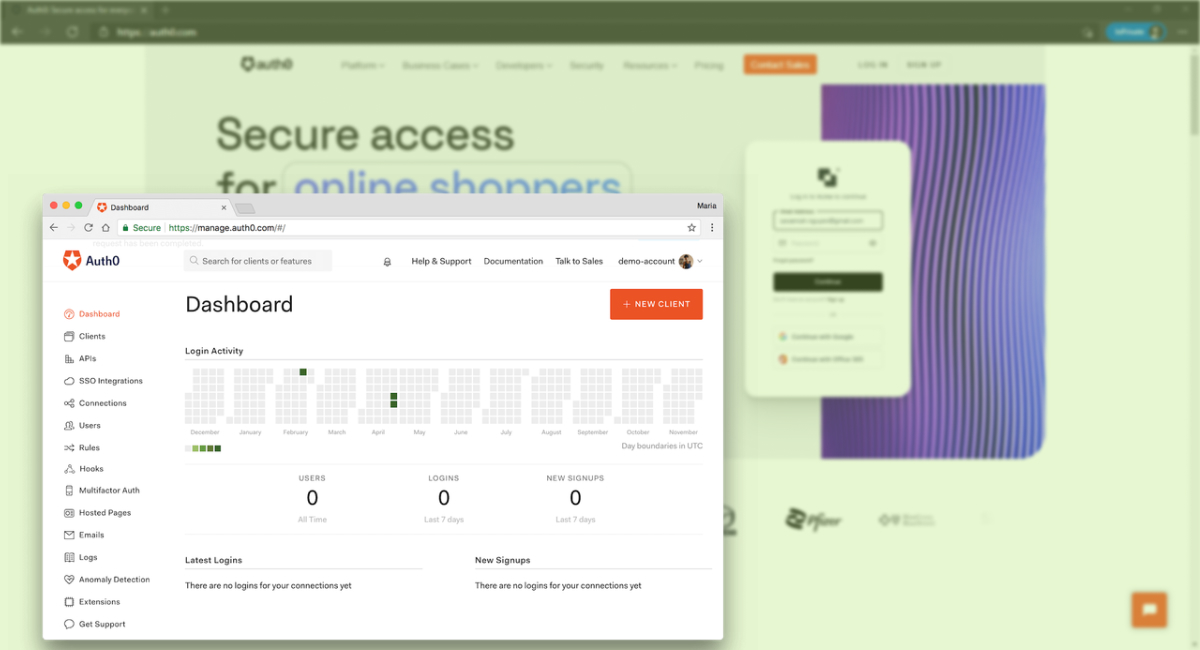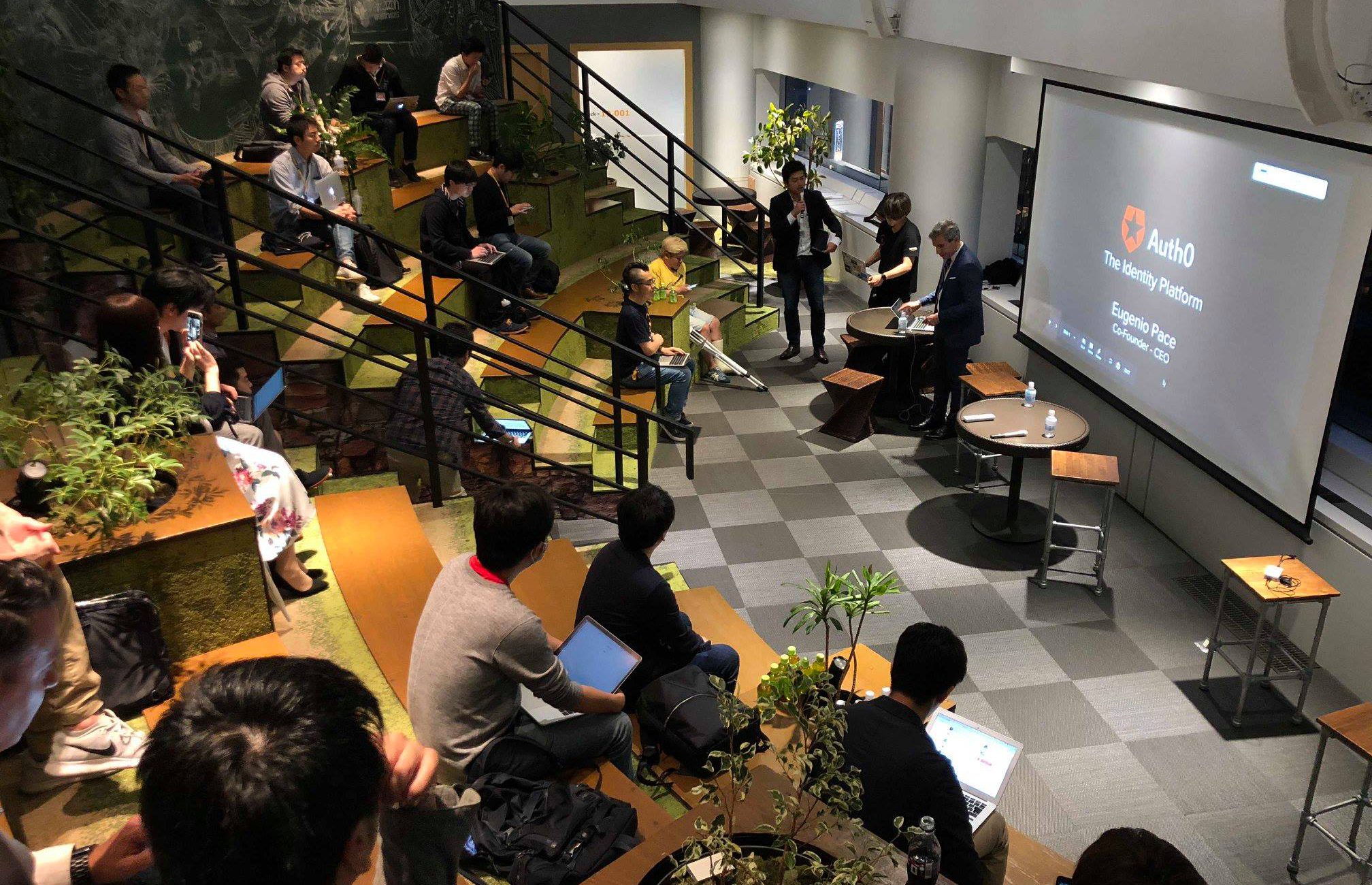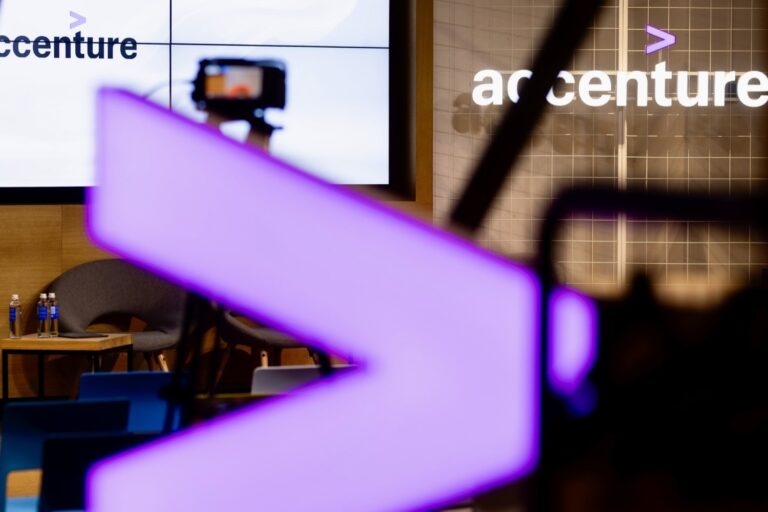The Rise of Auth0 and Lesson Seek from the Victory of $2 Billion Valuation
Approximately 650 employees worldwide and continues to be recognized as a leading private unicorn. Being included in the Forbes 2019 Cloud 100, Deloitte’s Technology Fast 500, and many notable awards, clearly Auth0 is game trying to compete old oak giants Microsoft and Okta. Obviously, with the previous earned capital the company is proved to be not an amateur and in strong position to play, so what is happening at the access gateway market?
What Is Authentication and the Access Gateway Market?
Authentication or what happen at the access gateway is the process of identifying users that request access to devices, network, or a system. At this point, access control often specifies user identity according to credentials like password and username. There are also other authentication technologies like biometrics and authentication apps are also used to secure modern systems including: Password-based authentication, Multi-factor authentication, Biometric authentication, Token-based authentication.
And because cyber criminals always in a fast pace to improve their attacks, security teams are facing an overloaded authentication-related challenges, besides, businesses have to move beyond passwords and think of authentication as a means of enhancing user experience. Not to mention the tech-savvy scenario we are entering, along with booming e-commerce and financial technology, which has stressed on the important role of identity and authentication and resulted in paving the way for access gateway market to thrive.
Based on a McKinsey report The Global Secure Web Gateway Market size is expected to reach $11.5 billion by 2025, rising at a market growth of 16.9% compound annual growth rate (CAGR) during the forecast period.
Auth0’s Memoir on Being a Unicorn Startup
For users, Auth0’s high tech makes sure their identity will be protected when the log in. For developers, the company is an effective and time-saving tool to authenticate users and ensure websites as well as mobile applications are secure.
Represent a developer-centric company, Jon Gelsey Auth0’s CEO claims it is riding the “developers-are-the-new-CIOs” wave. Because cloud computing is replacing traditional software, and the complexity of application development has increased, developers now decide the infrastructure and tools used by even the largest corporations in the world. Which has opened up a potential market for tech-savvy entrepreneurs who want to ease up developer’s live as the same time bring better value for business at all field in such high-tech era.
Last July, led by Salesforce Ventures, Auth0 announced that it has raised a $120 million Series F round. With this, the company has now raised a total of $330 million, including its $103 million Series E round in 2019, which launched the company into ‘unicorn’ status. After growing 70% in 2019, Auth0’s rapid growth has continued through Q2 2020 despite the uncertainty of the current global economic environment. The company says its valuation is now 1.92 billion.
Toward the company’s philosophy or the promise Auth0 has vowed since day 1 is that developers only need to add a few lines of code to their applications and the company will finish the rest.
How Will Auth0 Spend This Funding?
In term of funding, according to an interview on Built-in Seattle, Eugenio Pace the company’s founder claims for the last 2 years, Auth0 has nonstops growing internationally – including the expansion of its five offices in Bellevue, Buenos Aires, London, Sydney and Tokyo. Therefore, with this fresh capital, the company will focus on the growth of these newborns, especially on product marketing teams and developer-led-to-go-market strategy.
Investors at all sizes clearly show interests in Auth0 and believe it to be in a position to capture a good piece of the identity and access management market, despite the fact what a competitive space this is with the likes of IBM, Oracle, Microsoft, Okta, Ping Identity and others all striving for a similar pool of customers.
What Technical Challenges Is Auth0 Currently Working on?
In term of technical challenges, the company has proved to be a powerful platform as it is satisfied by thousands of customers globally. However, Pace stressed that they have never stop innovation and incremental changes in order to improve product and the experience of using it. Simplicity and flexibility are the two keywords the company is holding up to serves three key users groups including: end users, security teams and operators.
For end users particularly, Auth0 expect to reach an even “happier” balance between security and user experience. And for security teams, it claims to looking for more ways helping chief information security officers automate as much as possible while never compromising user security and privacy. For operators, whose day consist of keeping all systems humming admits a relentless barrage of inbound help desk tickets, it wants to help by decentralize and automate work by providing out-of-the-box integrations and self-service tools.
In brief, it is evolving the platform to a direction that could help reduce cost and complexity without ever compromising on security and privacy.
What Differentiate Auth0 Business Amongst Giants?
Even though it is a growing market, it is not a new one. Within such competitive landscape where the likes of giants such as Microsoft, IBM or Okta as well as the outbreak of seasoned entrepreneurs and smaller startups are building their own identity authentication software. What makes Ath0 different and how did it make a way out for such grand funding?
Toward this concern, Eugenio Pace answered in a Geekwire interview that the company’s biggest competitor is not actually any corporates but rather in the clients themself. Most applications in the world already have an authentication system, they need to know who the user is. In brief, Auth0’s service is a sunk cost.
However, the reality seems to contrast this believe that identity management is never a sunk cost. It’s an ongoing cost. You will always end up spending more time and effort than you able to, yet new attack vectors, and new uses cases, new problems would not stop coming up while your old system take nothing in account.

“Fortunately for us, we do not need to convince people that it easier to buy this than to it is to build themselves anymore.” said Pace.
While claiming the company is doing things that are really hard to replicate and no company is in a place of doing by themselves, like anomaly detection features or breached password detection features. The company can do all of that at scale as it operates at an aggregate number of users around 2.5 billion logins per month. That is a large number of interactions which has given all the underlying intelligence to detect anomalies.
Even though there are other companies that do have services in this space, but their approach has traditionally been not from a developer point of view, but more as an infrastructure black box thing, like an Active Directory or LDAP servers.
Founder’s Story: The Born of Auth0 and Lesson Seek from Eugenio Pace – a Tech Entrepreneur?
Eugenio Pace was destined to be a tech entrepreneur. He just jumped the gun.
After earning a degree in electrical engineering and a master’s in computer science in Buenos Aires, he launched a startup in his native Argentina. Young, inexperienced and lacking mentorship from other tech leaders, he thought that it was going to be enough to have a great idea for a new technology.
“Building a company is so much more,” Pace said. His enterprise failed.
But from there he landed a job with Microsoft, first working as a consultant in Argentina, and eventually moving to multiple management roles at its Redmond, Wash. headquarters, including senior architect evangelist. He stayed there nearly 13 years and became a U.S. citizen.
In 2012, he turned 42 and decided it was time to make a decision.
“My life could take two different routes,” he said. Remain at the comfort and likely success at Microsoft or seriously gamble with a startup.
“I always wanted to build something from scratch,” Pace said. So, he became co-founder of Auth0, a Bellevue-based business that provides a way for developers to easily set up authentication and identity verification. He gave himself a year to play out the idea.
Nearly six years later, Pace has become the CEO of the company. In 2020, Auth0 successfully raised $120 million to help fund its international expansion and hire hundreds of employees. Auth0 has raised $330 million since it launched.
For now, “Everything is more difficult. It’s like running a race with a backpack full of stones.” The current hyper-growth phase at Auth0 is another heavy load, Pace said. “The best recipe that I have is just surrounding yourself with the best possible people,” he said. And,
“Don’t assume what worked in the first year of your life as a company will work in the second year and the third year. Each year is a different beast.”
Tech Entrepreneur’s Viewpoint: How Auth0’s Culture Is Secured at This Hyper Scaling Mode?
As culture is the only unit that keep company thriving in the right path, talk on Auth0’s culture and how the company remotely keeps on scaling Eugenio Pace continues “When people say the most important thing is your team, it is true, but it requires a dedicated effort to make that statement true in everyday action. One of the things that makes us slightly different is that we have embraced a remote workforce.”
It’s been destined to be a long-distance relationship from the beginning, since Auth0’s co-founder Woloski lives in Argentina, Pace decides to make lemonade out of lemons and embraced technologies that allow them to work as if they were next to each other. From day one, he already has this mindset to unleash the pool of talent globally so recruitment procedure would be firstly for talent, secondly for time zone, and last for zip code.

To Pace it is not easy to compete for talent in Seattle, especially with Amazon, Microsoft and many more companies that are in good place and hire a lot. However, Pace think in some way companies are constrain themselves by only hiring people from one place. At Auth0, it has staffs in 35 countries. Even though it not easy to make that team works at a high performance, yet Pace believe he has invested in the right character and right skill sets, which mainly has brought up Auth0 of today.
Besides, as a leader Pace admitted it takes a lot of effort to make such a variable team to perfectly match, therefore, an investment in making that work is necessary. For instance, for their annual get-together the entire company just spent a week in Mexico to look back at many achievements, build connections and new plans.
Moreover, onboarding new employees is another heavy investment Pace stressed. “It’s silly that people hire new employees, give them a laptop and phone and say good luck. We invest a lot of time in making sure they are productive, and they have good training and good understanding of our mission.”
CEO’s Advice from the Core Values of Auth0’s Business Model
Pace’s first piece of advice to his fellow CEOs is to focus on customers. “A lot of young companies all they do is devote a critical number of resources just on funding. Fundraising is critical, but only if you have something to build on,” he says. “Once you have customers and you have traction, you’ll have no problem raising money from investors.”
As a matter of fact, the successful fund raising in Series F round has made Pace himself named Ernst & Young’s Entrepreneur of the Year for the Pacific Northwest.
His second piece of advice? When you are in your rising mode, try looking for and diving in a crowd that is better than you. “I was writing documents. Writing code. I was doing marketing. Engineering. Customer success. All at the same time. I actually enjoyed doing all of those things at the same time. But the way to grow is to find people who can do the job better than you.”
And last but not least, Pace’s as well as Auth0’s most important doctrine that even when you have found your niche in the market, remember that your product is never done. Not only especially true in high tech environments, but it is also true everywhere else.
What makes you successful the first year might not work the same today, as the race evolves, so too will your customers!
Developer’s Viewpoint: How Auth0’s Founder Eugenio Pace Approach Problems?
While at Microsoft, Pace’s operating field are mainly on then-emerging cloud technologies which have paved the way for a couple of books about modern identity management, that he publishes around 2009. Through that time, it was clearly to him that the issue of identity was getting bigger and becoming more troublesome as rising technologies created new scenarios and needs. Therefore, the question become what to build that could solve such challenges?

And while on the creative path to born Auth0, Pace claims that there are three design principles that are encoded into Auth0’s DNA and probably all high-tech solution should have: simplicity, extensibility and a true commitment to designing around developer customers.
#1 Simplicity
It is the norm, specifically within high tech environment, to know that if something looks very neat on the surface it must have a lot high-math solutions going on behind the scenes in order to achieve such appearance of simplicity. It’s everything designer or developers always try to tell you – it is always easier to add things than to remove them. Not to mention what Pace is trying to convert here is, at the same time of removing also increase the functionality delivered. For instance, take a look at how long it took to remove all the buttons from a mobile phone and how much more we can do with a button-less phone.
Many software companies get caught on the slippery slope of adding more features. As well as we understand the temptation, we know what tends to happen if you lost track: unpredictable interactions and scalability issues, a greater risk for bugs, slower run times with feature overwhelm, off-the-charts complexity or crumbling solutions that weaken the overall system.
The cliché “less is more” is truer than ever when it comes to software, but please note that “simplicity” is not lack of sophistication, yet the reverse is true! For instance, at companies like Auth0 or Stripe, they have to dig on a vast amount of complexity in order to produce a simple, plug-and-play solution. At Stripe, it gives one single API that helps hides all that complication from developers, no need to concern on how banks and clearing houses work. In addition, at Auth0, they provide an API that keep you from worrying all the ins and outs of storing users’ credentials, retrieving them or renewing passwords. No need to manually work through the behavior of different types of sign in methods—Apple, Google, Facebook, LDAP, active directory, or something more obscure.
In the course of developing solution at his company, Pace began by focusing on the most common 20% of use cases. Firstly, his team approach that 20% and then, over time – they work on the other 80%, which leads to Pace’s next design principle of extensibility.
#2 Extensibility
From very early, extensibility should be built-in because it allowed your customers to decouple themselves from engineering. You need to empower your customers, developers as the vast majority of them, to tweak the way our system works in a way that’s comfortable for them: with code. Not only should enable as you want them to write code that runs in your system, build up what you do.
It’s similar to the idea of Excel spreadsheets. As an Excel user, you don’t need to write the formula to perform functions like finding the sum or average for a range of numbers. Excel provides these functions built-in so that you can easily manipulate data right out of the box. However, you can also write your own formula if you can’t find one to suit your needs in the standard set. You don’t have to wait for Microsoft engineers to write that formula, you can create your own macro and get what you need without having to depend on anyone else.
For you are aiming at developers, your approach to extensibility should be the same idea. It has to allow customers to do whatever they want, give them the freedom to access to do things exactly the way the want them to be.
#3 Developer Centricity

Customer centricity or in case of services such as Auth0’s, it’s developer centricity. Focus on application builders has been the distinguishing element for Auth0 to successfully enter this market. In addition to being committed to the up-front work of learning everything you about customers’ needs, Pace shared there are several ways they have done on building a truly customer-centric organization.
Firstly, on the front end, you have to invest major time and resources into creating really great content. Go hired a relatively large team, have they to create a huge library of material, much of which should have nothing to do with your product, but rather on the common challenges and obstacles customers, in this case are developers, face. We know that developers do not like that wholesale, slick massaging approach, or anyone, customers want real value and developers interested in solving problems. Therefore, content marketing is the foremost solution, it made sense because it let you put the problems front and center and then offer valuable information to help developers solve those real problems.
Over time, as your content grew within the community the patient and hard work would monumentally pay off. Never forcing anyone to use your service and delivering content with intrinsic value is how you earn your way into people’s minds – to represent a helpful organization as well as to gain trust.
The Bottom Lines
We are seeing radical changes in how companies target and approach customers, everyday it’s getting more consumer-friendly and valuable through both the product and marketing strategy itself.
Especially the case of Auth0, the company is clearly not the pioneer, but it shows how effective the method works to give first and through trust earn later.









